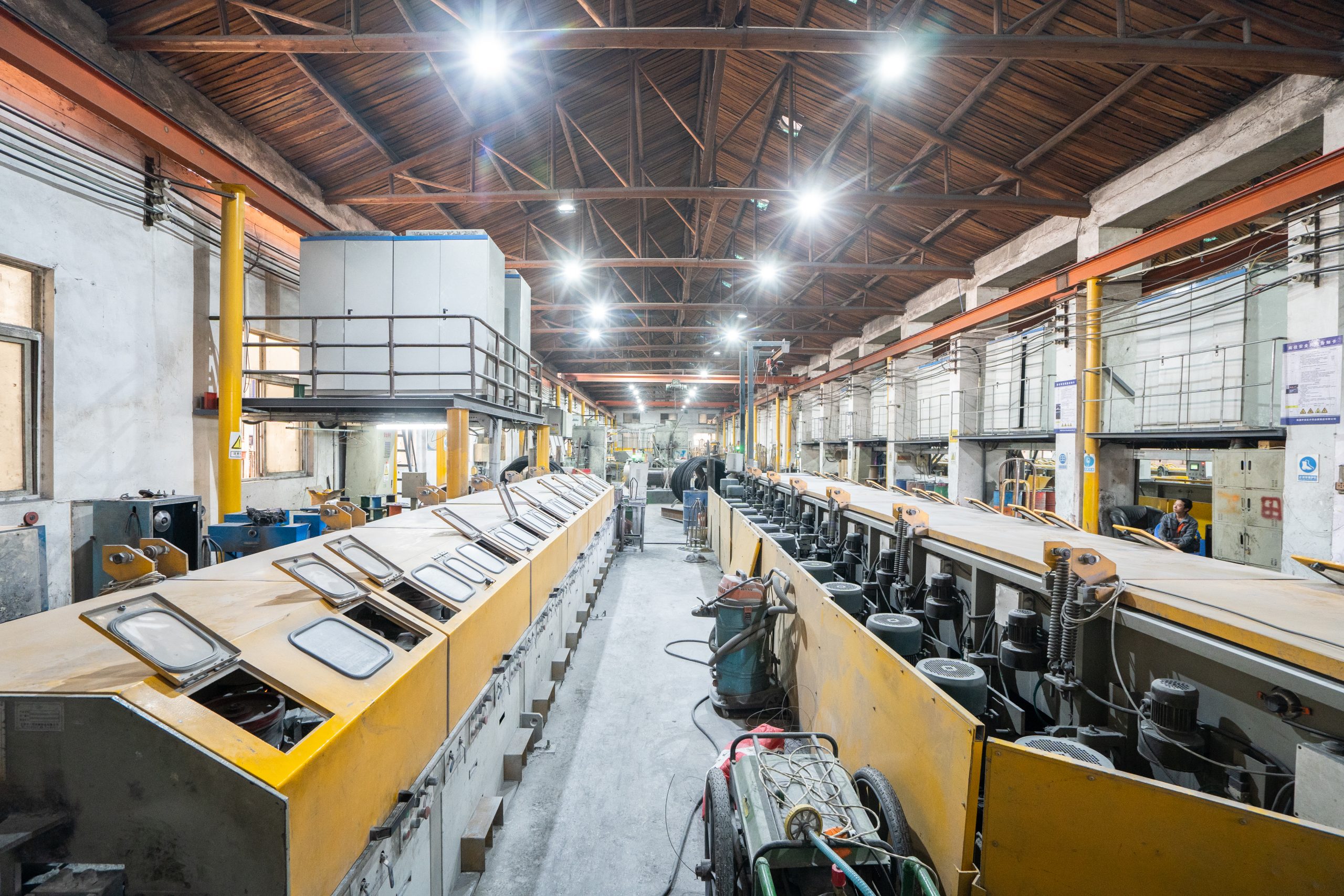Table of Contents
ลวดทองแดงเป็นวัสดุทั่วไปที่ใช้ในการเดินสายไฟฟ้าเนื่องจากมีการนำไฟฟ้าและความทนทานสูง การทำความเข้าใจหน้าตัดของลวดทองแดงสามารถให้ข้อมูลเชิงลึกที่มีคุณค่าเกี่ยวกับการนำไฟฟ้าและประสิทธิภาพโดยรวม ด้วยการตรวจสอบโครงสร้างของลวดทองแดงในระดับจุลทรรศน์ เราจะเข้าใจอย่างลึกซึ้งยิ่งขึ้นว่าอิเล็กตรอนไหลผ่านลวดได้อย่างไรและปัจจัยที่มีอิทธิพลต่อการนำไฟฟ้าของลวดนั้น
เมื่อเราดูหน้าตัดของลวดทองแดงภายใต้กล้องจุลทรรศน์ เราจะเห็นว่าลวดประกอบด้วยชุดอะตอมของทองแดงที่อัดแน่นกัน อะตอมเหล่านี้จัดเรียงอยู่ในโครงสร้างผลึก โดยแต่ละอะตอมใช้อิเล็กตรอนร่วมกับอะตอมข้างเคียง การจัดเรียงนี้ช่วยให้อิเล็กตรอนไหลผ่านเส้นลวดได้ง่าย ส่งผลให้ทองแดงเป็นตัวนำไฟฟ้าที่ดีเยี่ยม
ปัจจัยสำคัญประการหนึ่งที่มีอิทธิพลต่อการนำไฟฟ้าของลวดทองแดงคือความบริสุทธิ์ของตัวทองแดงเอง ทองแดงบริสุทธิ์มีค่าการนำไฟฟ้าสูงเนื่องจากไม่มีสิ่งเจือปนที่อาจขัดขวางการไหลของอิเล็กตรอน อย่างไรก็ตาม ลวดทองแดงส่วนใหญ่ที่ใช้ในงานไฟฟ้าไม่ได้บริสุทธิ์ 100 เปอร์เซ็นต์ เนื่องจากมักผสมกับโลหะอื่นๆ เพื่อเพิ่มความแข็งแรงและความทนทาน สิ่งเจือปนเหล่านี้อาจส่งผลกระทบเล็กน้อยต่อการนำไฟฟ้าของเส้นลวด แต่โดยทั่วไปแล้ว ลวดทองแดงยังคงเป็นตัวนำไฟฟ้าที่ดีเยี่ยม แม้ว่าจะมีสิ่งเจือปนเพียงเล็กน้อยก็ตาม
ปัจจัยสำคัญอีกประการหนึ่งที่ควรพิจารณาเมื่อวิเคราะห์หน้าตัดของลวดทองแดงคือ ขนาดและรูปร่างของเส้นลวดนั้นเอง ลวดที่หนากว่าจะมีความต้านทานต่อการไหลของอิเล็กตรอนต่ำกว่า ส่งผลให้กระแสไฟฟ้าไหลผ่านได้สูงกว่า ในทางตรงกันข้าม สายไฟที่บางกว่าจะมีความต้านทานสูงกว่า และเหมาะสำหรับการใช้งานที่ใช้พลังงานต่ำมากกว่า รูปร่างของเส้นลวดยังส่งผลต่อค่าการนำไฟฟ้าอีกด้วย โดยโดยทั่วไปแล้วลวดทรงกลมจะให้ค่าการนำไฟฟ้าได้ดีกว่าลวดแบนหรือรูปร่างผิดปกติ
นอกเหนือจากคุณสมบัติทางกายภาพของเส้นลวดแล้ว สภาพแวดล้อมที่ใช้ลวดยังส่งผลต่อสายไฟอีกด้วย การนำไฟฟ้า ปัจจัยต่างๆ เช่น อุณหภูมิ ความชื้น และการสัมผัสกับสารที่มีฤทธิ์กัดกร่อน ล้วนส่งผลต่อประสิทธิภาพของลวดทองแดง ตัวอย่างเช่น อุณหภูมิสูงอาจทำให้อะตอมของทองแดงสั่นสะเทือนแรงขึ้น เพิ่มความต้านทานและลดการนำไฟฟ้า ในทำนองเดียวกัน การสัมผัสกับความชื้นหรือสารเคมีที่มีฤทธิ์กัดกร่อนอาจทำให้พื้นผิวของเส้นลวดเสื่อมสภาพ ส่งผลให้ค่าการนำไฟฟ้าลดลงเมื่อเวลาผ่านไป
โดยรวมแล้ว หน้าตัดของลวดทองแดงให้ข้อมูลเชิงลึกที่มีคุณค่าเกี่ยวกับค่าการนำไฟฟ้าและประสิทธิภาพในฐานะตัวนำไฟฟ้า ด้วยการตรวจสอบโครงสร้างของเส้นลวดในระดับจุลทรรศน์ เราจะสามารถเข้าใจได้ดีขึ้นว่าอิเล็กตรอนไหลผ่านเส้นลวดได้อย่างไรและปัจจัยที่มีอิทธิพลต่อการนำไฟฟ้า ตั้งแต่ความบริสุทธิ์ของทองแดงไปจนถึงขนาดและรูปร่างของเส้นลวด มีหลายปัจจัยที่ต้องพิจารณาเมื่อวิเคราะห์ค่าการนำไฟฟ้าของลวดทองแดง เมื่อคำนึงถึงปัจจัยเหล่านี้ เราจึงมั่นใจได้ว่าลวดทองแดงยังคงเป็นวัสดุที่เชื่อถือได้และมีประสิทธิภาพสำหรับการใช้งานด้านการเดินสายไฟฟ้า

When we look at the cross-section of Copper wire under a microscope, we can see that it is composed of a series of tightly packed copper atoms. These atoms are arranged in a crystalline structure, with each atom sharing its electrons with neighboring atoms. This arrangement allows for the easy flow of electrons through the wire, making copper an excellent conductor of electricity.
One of the key factors that influence the conductivity of copper wire is the purity of the copper itself. Pure copper has a high conductivity due to the lack of impurities that can disrupt the flow of electrons. However, most copper wire used in electrical applications is not 100% pure, as it is often alloyed with other metals to improve its strength and durability. These impurities can have a slight impact on the conductivity of the wire, but in general, copper wire remains an excellent conductor of electricity even with small amounts of impurities.
Another important factor to consider when analyzing the cross-section of copper wire is the size and shape of the wire itself. Thicker wires have a lower resistance to the flow of electrons, allowing for a higher current to pass through them. In contrast, thinner wires have a higher resistance and are better suited for low-power applications. The shape of the wire can also impact its conductivity, with round wires generally offering better conductivity than flat or irregularly shaped wires.
In addition to the physical properties of the wire itself, the Environment in which the wire is used can also affect its conductivity. Factors such as temperature, humidity, and exposure to corrosive substances can all impact the performance of copper wire. For example, high temperatures can cause the copper atoms to vibrate more vigorously, increasing resistance and reducing conductivity. Similarly, exposure to moisture or corrosive Chemicals can degrade the surface of the wire, leading to a decrease in conductivity over time.
Overall, the cross-section of copper wire provides valuable insights into its conductivity and performance as an electrical conductor. By examining the structure of the wire at a microscopic level, we can better understand how electrons flow through the wire and the factors that influence its conductivity. From the purity of the copper to the size and shape of the wire, there are many factors to consider when analyzing the conductivity of copper wire. By taking these factors into account, we can ensure that copper wire continues to be a reliable and efficient material for electrical wiring applications.

